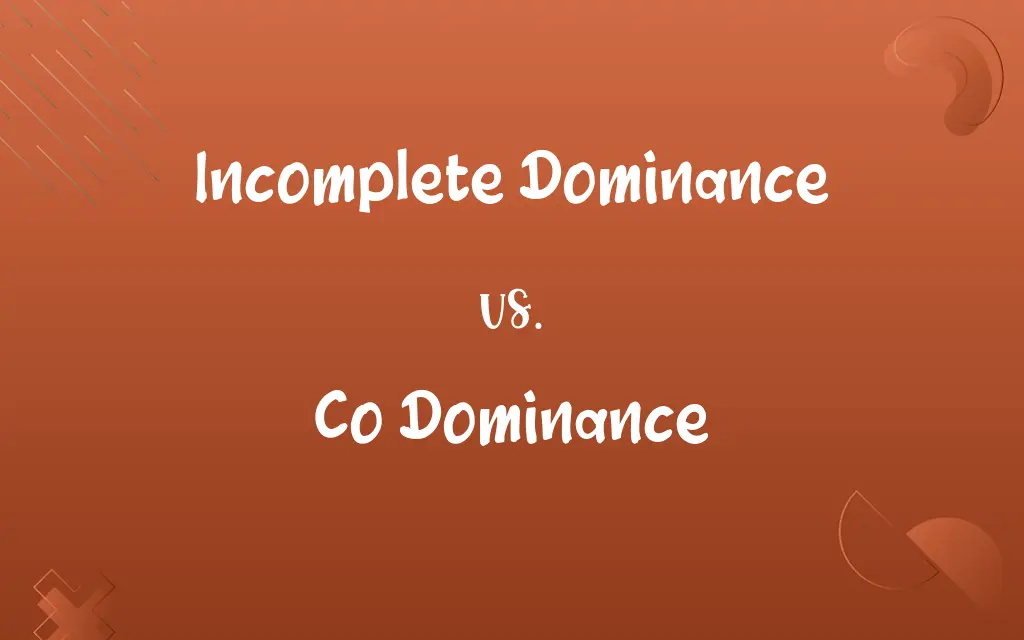Incomplete Dominance vs. Co Dominance: Know the Difference

By Shumaila Saeed || Updated on December 25, 2023
Incomplete dominance occurs when two alleles blend in the phenotype, while in co-dominance, both alleles are fully expressed and visible in the phenotype.

Key Differences
Incomplete dominance is a genetic scenario where the offspring's phenotype is a mix of the parents' traits, like in pink flowers from red and white parents. Co-dominance, on the other hand, results in offspring that express both parental traits distinctly, such as blood type AB in humans.
Shumaila Saeed
Dec 17, 2023
With incomplete dominance, no allele is completely dominant over the other, leading to a blended intermediate phenotype. In co-dominance, each allele maintains its individuality and is equally expressed in the phenotype.
Shumaila Saeed
Dec 17, 2023
Examples of incomplete dominance include the color of certain flowers or the fur of animals, where traits blend. Co-dominance examples are more distinct, like certain genetic disorders where both alleles are fully expressed.
Shumaila Saeed
Dec 17, 2023
In incomplete dominance, the heterozygous phenotype is different from either homozygous phenotype. In co-dominance, the heterozygous condition shows both traits independently and equally.
Shumaila Saeed
Dec 17, 2023
The concept of incomplete dominance helps explain variations in traits that don't follow simple dominant-recessive patterns. Co-dominance, conversely, is important in understanding how different alleles can coexist and be expressed fully in the phenotype.
Shumaila Saeed
Dec 17, 2023
ADVERTISEMENT
Comparison Chart
Phenotypic Outcome
Blend of both alleles' traits
Simultaneous expression of both alleles' traits
Shumaila Saeed
Dec 17, 2023
Expression in Heterozygotes
Intermediate phenotype
Both phenotypes expressed equally
Shumaila Saeed
Dec 17, 2023
Allelic Interaction
Alleles blend together
Alleles maintain individual expression
Shumaila Saeed
Dec 17, 2023
Example
Red and white flowers producing pink offspring
Blood type AB showing both A and B antigens
Shumaila Saeed
Dec 17, 2023
Genetic Explanation
Result of neither allele being completely dominant
Result of both alleles being dominant
Shumaila Saeed
Dec 17, 2023
ADVERTISEMENT
Impact on Phenotype
Produces a third phenotype different from parents
Shows both parental phenotypes simultaneously
Shumaila Saeed
Dec 17, 2023
Inheritance Pattern
Non-classical Mendelian inheritance
Classical Mendelian but with equal expression of alleles
Shumaila Saeed
Dec 17, 2023
Incomplete Dominance and Co Dominance Definitions
Incomplete Dominance
A genetic pattern where the offspring's trait is a mix of parents' traits.
The skin color in humans can show incomplete dominance, blending parental pigmentation.
Shumaila Saeed
Dec 03, 2023
Co Dominance
Co dominance occurs when two alleles are equally dominant.
In co dominance, a person with one allele for curly hair and one for straight might have a mix of both.
Shumaila Saeed
Dec 03, 2023
ADVERTISEMENT
Incomplete Dominance
A form of inheritance where the heterozygous phenotype is intermediate.
In snapdragons, incomplete dominance results in an intermediate color in the heterozygous flowers.
Shumaila Saeed
Dec 03, 2023
Co Dominance
Co dominance leads to a phenotype showing both alleles distinctly.
Human ABO blood types demonstrate co dominance in the AB phenotype.
Shumaila Saeed
Dec 03, 2023
Incomplete Dominance
Incomplete dominance leads to a third phenotype distinct from both alleles.
In certain types of chickens, incomplete dominance leads to a feather color different from either parent.
Shumaila Saeed
Dec 03, 2023
Co Dominance
A genetic scenario where both alleles are fully expressed in a heterozygote.
Co dominance is seen in human blood types, where AB is a result of both A and B alleles.
Shumaila Saeed
Dec 03, 2023
Incomplete Dominance
A genetic situation where the phenotype is a blend of both alleles.
In incomplete dominance, a red and white flower might produce pink offspring.
Shumaila Saeed
Dec 03, 2023
Co Dominance
A form of inheritance where both parental traits are visible in offspring.
Certain cattle breeds show co dominance in coat color, with patches of both parental colors.
Shumaila Saeed
Dec 03, 2023
Incomplete Dominance
Incomplete dominance occurs when no allele is fully dominant.
The wavy hair texture is a result of incomplete dominance between curly and straight hair alleles.
Shumaila Saeed
Dec 03, 2023
Co Dominance
A genetic pattern where heterozygotes express both alleles independently.
In co dominance, flowers might have spots of both red and white, representing each allele.
Shumaila Saeed
Dec 03, 2023
Repeatedly Asked Queries
Does incomplete dominance follow Mendelian inheritance patterns?
Incomplete dominance is a non-classical form of Mendelian inheritance with blended traits.
Shumaila Saeed
Dec 17, 2023
Is incomplete dominance common in plants?
Yes, incomplete dominance is often observed in the color of flowers in many plant species.
Shumaila Saeed
Dec 17, 2023
What types of traits exhibit co dominance?
Traits like blood type and certain animal coat patterns often exhibit co dominance.
Shumaila Saeed
Dec 17, 2023
What defines incomplete dominance in genetics?
Incomplete dominance is defined by a blended phenotype resulting from two different alleles.
Shumaila Saeed
Dec 17, 2023
How does incomplete dominance affect offspring phenotype?
In incomplete dominance, offspring have an intermediate phenotype, different from either parent.
Shumaila Saeed
Dec 17, 2023
How does co dominance differ from simple dominance?
In co dominance, both alleles are equally dominant and expressed, unlike in simple dominance where one allele overshadows the other.
Shumaila Saeed
Dec 17, 2023
Can incomplete dominance occur in human traits?
Yes, incomplete dominance can occur in human traits like skin color and hair texture.
Shumaila Saeed
Dec 17, 2023
What is a key characteristic of co dominance in genetics?
Co dominance is characterized by the full and separate expression of both alleles in the phenotype.
Shumaila Saeed
Dec 17, 2023
Can co dominance be observed in human blood types?
Yes, human blood types, especially type AB, are a classic example of co dominance.
Shumaila Saeed
Dec 17, 2023
Are there any health implications of incomplete dominance?
In some cases, incomplete dominance can influence the severity of genetic disorders.
Shumaila Saeed
Dec 17, 2023
Can environmental factors affect incomplete dominance?
While environmental factors can influence expression, they do not change the basic pattern of incomplete dominance.
Shumaila Saeed
Dec 17, 2023
Is co dominance observable in flower coloration?
Yes, in some flowers, co dominance can result in petals with distinct colors from each allele.
Shumaila Saeed
Dec 17, 2023
Does co dominance result in a blended phenotype?
No, co dominance results in a phenotype where both alleles are distinctly expressed, not blended.
Shumaila Saeed
Dec 17, 2023
Can co dominance occur in other organisms besides humans?
Yes, co dominance is observed in many organisms, including plants and animals.
Shumaila Saeed
Dec 17, 2023
How do researchers identify co dominance in genes?
Researchers identify co dominance by observing offspring phenotypes that clearly express traits of both alleles.
Shumaila Saeed
Dec 17, 2023
Does incomplete dominance have a predictable pattern?
Yes, incomplete dominance typically follows a predictable pattern of intermediate phenotype in heterozygotes.
Shumaila Saeed
Dec 17, 2023
How does incomplete dominance influence genetic diversity?
Incomplete dominance contributes to genetic diversity by creating phenotypes that are a mix of both alleles.
Shumaila Saeed
Dec 17, 2023
How does co dominance impact genetic studies?
Co dominance provides a clear example of how multiple alleles can express themselves in a phenotype.
Shumaila Saeed
Dec 17, 2023
Are there any specific tools used to study co dominance?
Geneticists use tools like Punnett squares and pedigree analysis to study co dominance patterns.
Shumaila Saeed
Dec 17, 2023
How does understanding co dominance help in medical genetics?
Understanding co dominance aids in predicting genetic traits and understanding certain diseases in medical genetics.
Shumaila Saeed
Dec 17, 2023
Share this page
Link for your blog / website
HTML
Link to share via messenger
About Author
Written by
Shumaila SaeedShumaila Saeed, an expert content creator with 6 years of experience, specializes in distilling complex topics into easily digestible comparisons, shining a light on the nuances that both inform and educate readers with clarity and accuracy.








































































